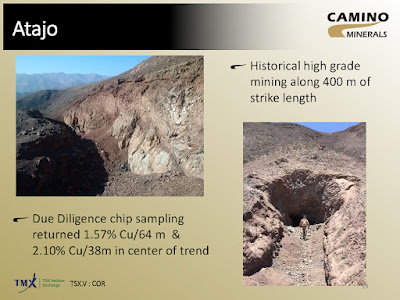June 19th (link)
 |
| fap |
July 7th (link)
 |
| fap fap fap fap fap fap |
Some cock-stiffening intercepts, and Newrange have nicely included some geo-porn
| This picture was sponsored by Vaseline for dry and sensitive skin.... |
Summary
- Massive grade smearing, gold is found in high-grade structures
- No strong evidence for a large disseminated deposit.
- Small areas of disseminated mineralization mineralization found where multiple structures intersect.
- Poor drill program execution - no real testing of structures, drilling appears almost random
- RC drilling in a narrow structure gold deposit = cheap and nasty. Important controls on mineralization may be very hard to determine from small rock fragments.
- RC drilling can also lead to significant grade smearing if not conducted carefully.
- Next to the western hemisphere's largest munition storage facility
- Negative: US military may not like explosives being next to its dumps
- Positive: May be able to get cheap explosives
- There has been significant prospecting around the project, there could be a chance to develop several several small high-grade zones into a moderate sized resource.
Rock Rant
I'm very disappointed with the drilling. Newrange are using RC drilling to explore the project. I understand that it is quick and most importantly, cheap, but you end up losing so much information.
The holes appear to be almost randomly orientated - what are they actually trying to drill?
They have the mapping and sampling from the ramp that identified 2-3 gold bearing structures.
| red dashed line = traces of structures in the ramp |
Why didn't they follow those along strike to see where they go? It looks like they have been very lucky, or do we have a forgiving, disseminated gold deposit?
Let us put the data through the de-intervalator:
| ta daaaaaa! |
Newrange have done a David Copperfield! All that beautiful gold has disappeared. Why?
You've guessed it, we have some beautiful examples of grade smearing. I would hate for a nEwsletter wrIter to have been confused by the press releases and think that there was potential for a high-grade disseminated deposit!
That big green hole is hole 17, my favorite:
- We go from: 70.89m @ 3.57 g/t Au
- To: 65.54m @ 0.396 g/t Au surrounding a couple of high-grade zones running
- 4.58m @ 48.3 g/t Au
- 0.76m @ 35.4 g/t Au
Note: 0.396 g/t Au = Waste (unless you're Coeur, when it represents a 'buying opportunity')
So to put it bluntly - 89% of the gold in 7.5% of the rock. No disseminated potential here, but it isn't all bad news, they have a ramp going into that zone, and so I wanted to understand the controls on mineralization.
| Pam's varicose veins |
From this I built a vein model to see if the thick hits were from wide, high-grade veins or some luck from drilling down the vein (so a wide apparent width). The veins were modeled by projecting the information mapped in the decline and linking them up with assays along strike.
Plan view
So we have 3 principal veins
| Holes drilled sub-parallel to veins = long intercepts! |
The cool thing is, when you bring all those veins together, you get this:
| Red box = area of thick >1 g/t Au intercepts |
By building up a decent 3D model you can start to see how the pieces fit together. There is a small zone of >1 g/t disseminated mineralization where the 3 structures come together. The nice thing is that it is close to the ramp, which provide Newrange the potential to define a small tonnage "bulk sample" that they could extract and process to generate some news and maybe some loot.
Here is my Palmico model (link)
 |
| highest gold values where the veins come together, that's original |
District potential
This is what is interesting about Pamlico. in the initial drilling there hasn't been much evidence to support a large, disseminated deposit, but with careful, focus drilling (with a fecking core rig) Newrange may be able to define several small, high-grade zones that could hypothetically feed a small operation.
If you look at the entire district (and I am assuming that Newrange has most of it), you can see:
| a metric feck tonne of veins |
There are heaps of workings, following veins/structures for >1km along strike. There could be many, small high-grade zones there.



